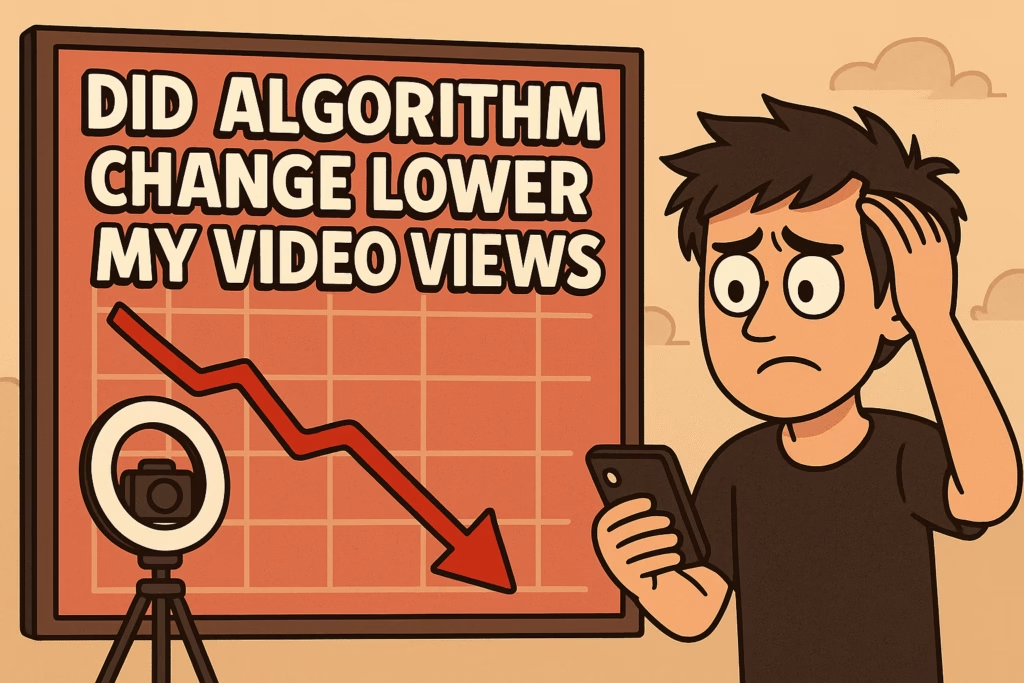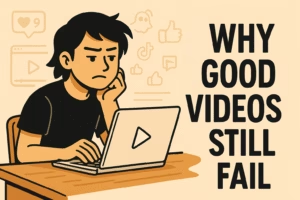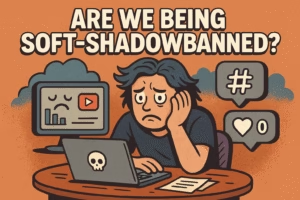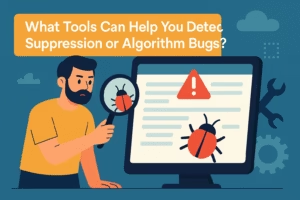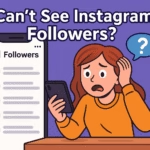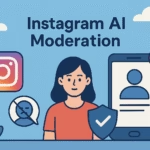One day you’re pulling 20,000 views in your sleep. The next, you’re staring at 83 views after 24 hours. Same content. Same editing. Same strategy. Just… silence. Welcome to TikTok in mid-2025 — where even seasoned creators are starting to feel like they just downloaded the app yesterday.
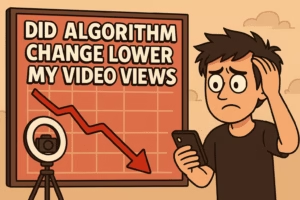
Across multiple niches — music, beauty, tutorials, and more — creators are quietly sounding the alarm. Your TikTok Views Suddenly Dropped. Engagement has nosedived. And even “good” videos are mysteriously going nowhere.
So what the hell is going on?
The Short Version:
-
TikTok creators are reporting that their TikTok views suddenly dropped 90% since late April 2025.
-
This is affecting consistent, high-effort accounts — not just beginners.
-
“Under review” tags, unpredictable reach, and low-engagement plateaus are common symptoms.
-
Some believe TikTok is deprioritizing older accounts unless they pay to promote.
-
A small minority remain unaffected — suggesting TikTok may now judge videos in isolation, not based on past performance.
Need to check if your content is being suppressed or filtered out? Tools like Social Proxy let you test how your videos behave on fresh devices and networks.
What Changed After April?
If you’ve been posting regularly on TikTok and suddenly your views cratered, you’re not alone. Something shifted around late April to early May. The signs were subtle at first — slower view velocity, fewer likes, oddly inconsistent reach. Then, for many creators, it was like someone pulled the plug. Videos that once hit 10k views were now struggling to cross 100. And no, it’s not your niche. It’s not your editing. And no, you’re not crazy.
What makes this drop especially frustrating is that it isn’t tied to quality or effort. Creators who’ve maintained the same workflow — pre-recorded, professionally edited, consistently themed videos — are seeing drastic performance dips overnight. Beauty influencers, musicians, editors, educators — all reporting the same pattern: views are down, engagement is unstable, and nothing they change seems to fix it.
So what happened?
It may have started with TikTok quietly tweaking the way content is reviewed and released to the For You Page. Videos now seem to spend more time in “under review” limbo — and for some, that period never ends. Creators report uploading solid content, only to find their video pushed to barely any users before stalling out entirely. No error. No takedown. Just… algorithmic purgatory.
There’s also growing speculation that TikTok has restructured its ranking system. Previously, high-performing accounts often had a kind of “inertia” — their content got early boosts based on past success. That seems gone. Now, every post is on trial like it’s your first day on the app. Long-time creators are being evaluated the same way as brand new accounts — and that’s a major shift in how the system rewards consistency.
This would explain the eerie feeling many have: that they’re suddenly invisible. No growth. No traction. And worst of all, no explanation.
The Rise of Algorithm “Luck” — And Why Good Videos Still Fail
If you’re making good videos and still getting ghosted by the algorithm, you’re not delusional — you’re just up against something that now resembles a digital lottery.
What used to be a semi-consistent system — where niche content, solid watch time, and decent engagement earned you exposure — now feels like a dice roll. One video gets 60 views. Another, posted hours later with similar structure and quality, randomly spikes to 20k. Then you’re back to 110 views and radio silence. No pattern. No logic. Just chaos.
TikTok seems to have gutted its old feedback loops — the ones that favored consistency, specialization, and past performance. Instead, it’s testing every post on a blank slate. Your follower count? Practically meaningless. Your content history? Irrelevant. Your entire creative identity? Wiped from the equation. What matters now is the first few seconds of your current video… and how it performs with a test group that may or may not even be your target audience.
This explains why some creators are seeing videos jump from 100 views to 1 million overnight — while others, with objectively better content, can’t even cross 500. It’s no longer about effort or strategy. It’s about hitting the algorithm’s mood at just the right time, with just the right thumbnail, hook, and luck.
This shift has serious consequences. It erodes motivation. It punishes creators who care about storytelling. And worst of all, it makes consistency feel pointless. Because when a polished, well-structured, edited video can tank — while a low-effort trend copycat goes viral — the message is clear: you’re not building equity, you’re spinning a roulette wheel.
How TikTok’s Review System Is Quietly Killing Reach
A growing number of creators have noticed something odd: their videos are stuck in “under review” status… sometimes indefinitely. There’s no flag. No rejection. No takedown notice. Just a quiet delay where TikTok decides — in its own time — whether your content deserves to be seen. And that delay is killing momentum.
When a video is first uploaded, the first 30 to 60 minutes used to be critical. That’s when TikTok would sample it to a batch of users and determine if it was worth showing to more. But now? Many creators are watching that window go completely dark. Zero views. Zero notifications. No signs of life until hours later — and by then, it’s already too late. The algorithm has moved on.
Some speculate this is TikTok’s new way of throttling content without overtly shadowbanning users. Instead of saying “No,” they just let your video time out. If it doesn’t pop off instantly, it gets buried.
And this isn’t just happening to questionable content. Creators who are posting original music, tutorials, clean humor, and well-edited reels are being caught in the same purgatory. What’s worse is that even when the video is finally released to the feed, its reach seems artificially capped — barely hitting even your own followers, let alone new audiences.
There’s also an eerie pattern with videos that do go under review. Some perform exceptionally well — almost like the system rewards you for waiting. Others completely tank. The inconsistency only adds to the paranoia.
If TikTok has in fact added a layer of silent content review — either automated or manual — then creators are now playing a guessing game with each upload. What will pass? What will stall? And is it even worth the effort anymore?
Are We Being Soft-Shadowbanned — Without Even Knowing It?
Let’s be blunt: if TikTok wanted to shadowban your account, they wouldn’t tell you.
And that’s exactly the problem.
There’s a growing theory among creators that we’re not dealing with traditional shadowbans anymore — the kind that completely block your visibility or take down your content. Instead, we’re facing soft shadowbans. You’re not blocked. Your account isn’t restricted. But your reach? Quietly throttled into the dirt.
Here’s how it works.
Your content still appears — but only to a narrow slice of your followers. Engagement comes slower. New audiences never see it. Even when your content aligns with your usual strategy, performance flatlines. There’s no error message. No alert. Just this creeping feeling that the app is ghosting you in slow motion.
And for creators who used to average 5k–20k views regularly, a sudden drop to 80–200 is not business as usual. It’s suppression — but wrapped in plausible deniability. TikTok can always say, “You’re not banned. Your content is live.” Which is technically true, and totally useless.
To be clear: not every drop in performance is a shadowban. But when consistent creators with established audiences, optimized content, and no violations all see identical tanking patterns? Something’s up.
If you’re trying to diagnose whether this is happening to you, don’t just rely on view counts. Watch for:
Videos dying after the first 10–20 minutes
A sudden lack of views from non-followers
Drastic shifts in like ratios (e.g., 3,000 views, 6 likes)
The same content doing well on other platforms (e.g., Instagram Reels)
Repeated prompts to “Promote this video” despite low initial reach
No, TikTok won’t confirm any of this. But if your gut says something is off, you’re probably right.
Why Reposting or Changing Niches Might Backfire
In a desperate attempt to fix tanking reach, many creators make the same mistake: they start reposting old hits or pivoting into unrelated niches. And most of the time, it backfires — hard.
On paper, reposting makes sense. If a video went viral before, maybe TikTok just needs a reminder. But today’s algorithm doesn’t work like that. Reposting now triggers a completely different evaluation. TikTok treats reposts with extra caution — often flagging them as recycled or low-value. Even if you tweak the edit slightly or change the caption, the system may still recognize it and suppress it.
Then there’s the niche switch trap.
If your views are down and your usual content isn’t working, it’s tempting to try something totally different. But here’s the catch: TikTok is more likely to push new content only to a fresh test group — one that doesn’t match your usual audience. That means your experiment gets tossed into an entirely random pool. If it doesn’t explode immediately, it disappears faster than usual.
Now you’re dealing with two problems:
Your usual audience is disengaged.
The new content never finds a foothold.
This is why even high-quality creators get caught in algorithm quicksand. You post what you’ve always posted. It doesn’t work. You panic, pivot, and now your account’s identity is a mess. The algorithm doesn’t know who to show your content to — and neither do your followers.
This doesn’t mean you shouldn’t evolve. But if you’re going to test new styles, do it strategically. Don’t abandon your niche overnight. Instead, layer in adjacent content, see what performs, and let the data guide your shift.
What Actually Works Right Now — According to Surviving Creators
Despite the chaos, not everyone is tanking. A few creators are still pulling views — not because they cracked some secret code, but because they made micro-adjustments that align with TikTok’s new behavior.
Here’s what seems to be working right now:
1. Hyper-short intros
You have less than 1.5 seconds to hook someone. Long intros are death. Cut straight to the action. The opening frame should scream “This is worth watching” — or it’s game over.
2. Native text layering
TikTok wants your video to feel “native” to the platform. That means using the in-app text editor (not just Premiere or CapCut), even if it’s just a headline or CTA. Native text helps the system understand your content faster — and improves delivery.
3. Relatable over polished
Ironically, high-end editing might now be working against you. TikTok’s FYP currently favors authentic-feeling videos. Even if your production quality is high, make sure it still feels like something a human made on a phone, not a brand studio.
4. Watch time + rewatch triggers
With the new algorithm seemingly reset to judge videos individually, the strongest survival metric is rewatch rate. Loops that make people rewatch, subtle movement, audio tricks — these are the difference between 500 views and 50,000.
5. Small experiments, same style
Creators seeing some consistency are sticking to their niche but testing different formats: changing camera angles, experimenting with hooks, or remixing past hits in creative ways. The goal isn’t to pivot — it’s to test without confusing the algorithm.
6. Avoid rapid posting
Some creators reported a “hard cap” on daily performance if they post more than 5–6 times. After that, TikTok allegedly throttles the rest. Whether true or not, limiting your posts and focusing on quality over quantity seems to help.
So no, you’re not powerless. But if you’re still treating TikTok like it worked in 2023 or early 2024, you’re going to get eaten alive. The game has changed.
What Tools Can Help You Detect Suppression or Algorithm Bugs?
Before you throw your phone into a lake and swear off social media forever, know this: there are tools that can help you figure out whether you’re truly being suppressed — or just caught in the storm.
You don’t need to guess. You need data. Here’s what’s worth trying:
1. Fresh Device Testing
One of the fastest ways to spot a stealth ban or suppressed reach is by testing your content on a completely fresh device or account. Upload the same video (privately or to a test account), then compare how fast it gains traction. If your main account stalls while the test account pops off — something’s wrong.
2. Social Proxy (IP + Device Testing)
Social Proxy is built for these kinds of diagnostics. It allows you to test how your content performs across different IPs, devices, and environments — crucial if you suspect you’re flagged by TikTok’s behavioral detection systems.
Creators who suspect they’re being sandboxed often use proxies to mimic new-user behavior and see if their reach improves. It’s also useful for managing multiple accounts without triggering TikTok’s filters.
3. Manual Review Triggers
Some creators have successfully reversed algorithmic stalls by intentionally triggering manual reviews. How? They upload borderline viral content and wait for the “under review” tag — then submit a help ticket politely asking for confirmation the video doesn’t violate guidelines. Sometimes this clears the block and boosts future performance.
4. Engagement Diagnostic Tools
Platforms like Flick (yes, originally a hashtag tool) have advanced analytics dashboards that help detect sudden drops in engagement, changes in follower behavior, and video-by-video analysis of performance trends. It’s not just for Instagram — many creators use it to cross-analyze TikTok performance trends too.
5. Cross-Platform Testing
Still unsure if the content or the platform is the problem? Post the same video to Instagram Reels or YouTube Shorts. If it performs dramatically better elsewhere, chances are TikTok’s system is throttling you — not your creativity.
In short: don’t rely on vibes alone. Use every tool at your disposal to figure out whether it’s your content, your account, or the platform’s shifting goalposts that are to blame.
Should You Start Over With a New Account?
When your views flatline, your likes vanish, and TikTok’s support system might as well be a ghost town, it’s tempting to do the nuclear thing: start fresh. New account, new content, new chances. But before you hit that reset button, let’s talk about what actually happens when you abandon your main.
Spoiler: it’s not always better.
The Case For Starting Over
Some creators report immediate results from launching a new account. Their first few videos get thousands of views. The algorithm seems to push them out aggressively — possibly to test engagement or give new users a dopamine boost. If your old account is deeply suppressed (or flagged internally), starting over might feel like freedom.
But that’s usually short-term.
New accounts often get a grace period, sometimes called the “honeymoon phase,” where TikTok aggressively samples content. But if those early posts don’t go viral or spark consistent watch time, the account quickly drops into the same reach drought you just left. Worse, you now have no audience history, no credibility, and no saved momentum to build on.
The Risk of Account Linking
TikTok also tracks device IDs, IP addresses, behavioral patterns, and user associations. So if your new account logs in from the same phone, on the same Wi-Fi, and posts the same content… the system might quickly treat it as an extension of the suppressed one. In other words, you could be recreating the problem in a new shell.
The Smarter Alternative
Instead of nuking your progress, try this:
Audit your content: Check what performed just before the drop. Was there a format, caption style, or audio trend that hit? Rebuild from that foundation.
A/B test with burner content: Create a new account for experiments — not as your main. Use it to test reach, edits, and upload timing without risking your primary channel.
Separate your setup: If you do go new, do it properly. New device, new SIM, new IP. Treat it like a clean lab test — not a casual second profile.
Resetting can work. But most of the time, it’s an emotional reaction to a system that feels broken — not a strategic solution.
Where Creators Go From Here — And Why This Isn’t the End
Let’s be clear: TikTok isn’t dead. It’s evolving — and creators who understand the shift will survive it. Maybe not with the same reach. Maybe not with the same speed. But they’ll outlast those who burn out, give up, or blindly restart every time the algorithm changes mood.
Yes, the platform has gotten more unpredictable. Yes, it’s more frustrating than ever. But if you’re still here — still posting, still testing, still analyzing — you’re already ahead of most.
Here’s what matters now:
Play the long game. This isn’t about chasing trends for quick dopamine. It’s about building systems: workflows, backups, style, and resilience. Make content that compounds.
Diversify early. If TikTok is your only distribution channel, you’re vulnerable. Cross-post to Reels, Shorts, or even Pinterest Video. Not for vanity metrics — but to see what platforms value your style.
Own your list. If your TikTok died tomorrow, how would you reach your audience? Build an email list, a Telegram channel, or something off-platform. You don’t need thousands — just the right hundred.
Track smarter. Tools like Social Proxy let you know when it’s them, not you. Stop guessing and start measuring.
Don’t take it personally. The algorithm is not a reflection of your talent. It’s code. Your worth isn’t tied to your last post’s reach.
Ultimately, the creators who win are the ones who adapt faster than the algorithm mutates. You don’t need to go viral every week. You just need to stay in the game long enough to outlearn everyone else.
TikTok might be harder now — but that’s exactly why it’s still worth fighting for.
